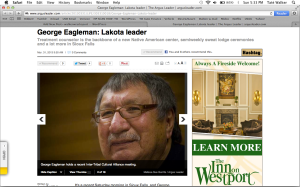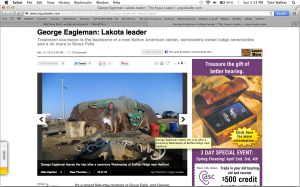My kindergartener loves school. Just loves it. She comes home everyday with a song on her lips and happiness in her heart for all her friends, her awesome teacher, and the billions of pieces of artwork she hangs throughout the house. Her latest lyrical lay is the Pledge of Allegiance, followed by My Country ‘Tis of Thee. She knows every single word of both songs, and her lisp makes them sound extra patriotic, because she fights so hard to get the “s” out clearly. Bless her.

Before I get into the politics of parenting and pledging, a few things. First, I’m of the mindset that my kid should have the independence and the freedom to choose what she does and doesn’t like, while at the same time having and showing respect for the values of others. For example, I’m not a religious person, but I’m all for her going to Catholic church with her grandparents if she chooses to and with the understanding that she also is exposed to other types of faith (she has a slew of Muslim friends, and we practice Lakota spirituality at home; and in this my most <sarcasm>favorite</sarcasm> of holiday seasons, we attend Jewish events open to the public — one of my greatest fears is raising an ignorant child, and so I try everyday to empower her with all sorts of knowledge). Likewise, I’m all about her singing songs she enjoys, so long as she can grasp their meaning. She came home singing Peter Peter Pumpkin Eater a few weeks back and we had a great discussion about what exactly his wife was doing in a pumpkin shell and that maybe that wasn’t the best place to put someone you love. She totally got it. “No one’s gonna put ME in a pumpkin shell.” Or a corner, Baby.
With the Pledge, things get a bit trickier. Ironically, the most patriotic places in America are powwows and under-funded and overcrowded public schools. Just this week the board of the Sioux Falls School District voted to make the Pledge of Allegiance a mandatory, daily occurrence in elementary and middle schools, but not in high schools. There’s more to it than that – you can read the story here. “What we did on Tuesday night was to expand a policy that required the Pledge of Allegiance at the elementary schools to include middle schools and to make it mandatory. We also have given high schools, in policy, instructions to either have the Pledge or presentation of the colors or something patriotic at any high school assembly,” Sioux Falls School District board member Kent Alberty said in a follow up story (noted below). Underlined emphasis is mine.
But it’s not so much the when and where that’s discomforting, but the fact that the board needed to vote on it at all. It rubs the wrong way to force my kid to be a sheep every morning. Oh yeah, and now with all the hullaballoo a local state senator is trying to make the Pledge a requirement throughout all of South Dakota’s public schools. Add that to the “Trying Too Hard To Get Reelected” pile.
What’s interesting to me is how these patriots (publicly elected school board members and state senators) completely overlook constitutional rights (yet another example that our state needs to put more funding into education, especially for things like government, civics, and social studies, and spend less time passing resolutions allowing public school Bible studies and laws that allow armed school sentinels). Lest we all forget (because, apparently, lots of public officials in South Dakota have) the First Amendment guarantees the right of anyone (read: any age/grade) to not participate in the saluting of the US flag (including recitation of the Pledge). Let’s go back to the 1940s – 1943, specifically – when the US Supreme Court heard West Virginia State Board of Education v. Barnette:
If there is any fixed star in our constitutional constellation, it is that no official, high or petty, can prescribe what shall be orthodox in politics, nationalism, religion, or other matters of opinion or force citizens to confess by word or act their faith therein.”
Justice Robert Jackson, writing for the majority.
OK now let me say this, because everyone and their dog is going to say I hate veterans because I don’t Pledge to the flag (“You ungrateful, terrible mother! Those veterans fought for your right to bitch on a blog!” <— Yeah, and for whatever reason my taxes support wars I don’t, and fail to support the returned homeless/disabled/struggling vets I do): Nationalism and patriotism are great if they make you a better person – a better person to your family, neighbors, your land, and yourself. Go you! In general, I think people who join the military as a means of protecting and serving are swell — they deserve recognition, surely. I mean, my Facebook feed went NUTS last Monday – yay for one day a year we dedicate a status to veterans… Seriously, folks. I have lots of love for military veterans, past and present, US and indigenous and even those from other countries. In fact, there are plenty of veterans in my immediate family circle (many of whom were drafted), all of whom sacrificed much for their country (during and after conflicts) and should be honored.
But paying tribute to those individuals who fought and bled and maybe even died in uniform is a totally different beast than what I’m talking about here, which is forcing children – my child – into ritualized and mindless recitation of concepts they are simply too young and inexperienced to comprehend. Really, people – my kid is just learning to spell and read. Heck, she didn’t even get through her whole name on that Pledge book she made. What exactly do you expect her to take away from lines like “and to the Republic, for which it stands” or deeply contextual words like “indivisible?” Let’s not even get started on the non-traditional but super-controversial “under God” edit of the 1950s. And before one more person says, “Well, the school isn’t really forcing anyone to say the Pledge… Your daughter doesn’t have to stand or sing…,” lemme just ask how confident YOU were at 5 or 6 or 15 to go against the grain of what EVERYONE was doing in your class???
For me – and for a lot of marginalized people – the flag and its pledge represent colonialism, capitalism, and privilege (among other things); quite simply, the message of patriotism is, “We are better.” So what does that say about me? What does that say about the thousands of families in Sioux Falls who aren’t American citizens? As the descendent of American holocaust survivors (read: indigenous people), and as a member of a sovereign nation that continues to struggle for survival in the Land of Plenty, I’m not sold on US patriotism and its faux idealism — “…with liberty and justice for all…”??? *gag* Give me a break. Tell me what reciting the Pledge has done for women’s equality (let’s talk about rape in the military, shall we?), justice reform, gay couples, Native kids in foster care, or young Black people carrying Skittles or asking for help?
The Sioux Falls school board said high schools didn’t need to recite the Pledge because of scheduling conflicts, but I’d wager it also has something to do with the fact there are more people capable and willing to use their brains and voices to protest shady American policy and practices by not standing for (or standing but not reciting) the Pledge of Allegiance. To make little kids do it without them realizing the implications or the bloody history (/current events) inherent in US patriotism is wrong.
I vote. I pay taxes. I volunteer. I see the flag flown at public buildings, which includes every single public classroom in Sioux Falls. And I stand for the flag (and other nation’s flags) out of respect, not of blind agreement. My values and beliefs (read: taxes) deserve respect, too.
No, I don’t say the Pledge. I don’t sing any song to a flag, unless it’s the Lakota National Anthem. (‘Cause you feel that song. It’s not some tune that rhymes that can be regurgitated by the masses – you have to earn it.) I wouldn’t go so far as to say I’m protesting; I’m just exercising my constitutionally protected right not to conform to herd mentality, and I’m also educating my daughter as she grows and learns and develops her own unique perspective.
That said, my daughter and I discuss US/Native history all the time (Halloween – and now Thanksgiving, sports mascots, and fashion alone give us plenty to talk about). It wasn’t so long ago, I tell her, that patriotism meant stealing and killing the land because gold was found in the sacred Paha Sapa (we haven’t touched on WMDs and Middle East policy yet). It meant being rewarded for procuring the ‘red skins’ of savages, taking kids from their tiospaye, cutting our hair, and banning our language and religion. Because my baby is a soft-hearted soul, she sympathizes with the person who was forced to move away from their home or the people they loved. At 5, she’s more morally sound than a lot of politicians and knows it’s not OK to kill people for land or for money. She knows our hair and Lakota language and Takunsila are important enough to fight for, even though she hates getting her hair braided and is still learning her Lakota (and Ojibwe!) ways.
And so we talk about how she can listen to her teacher and respect the flags of every nation by standing. She doesn’t have to do more than that if she doesn’t want to. And when she said, “Mom. Is it OK if I do want to?” Though my heart broke a little, I said, “Of course,” because I don’t ever want her to think she has no say in what she does or does not do.
Then we smudged. Because there’s got to be balance in the world 🙂
11/20/13 An update: Reports came out today that board members of the Sioux Falls School District have received harassing messages (and even some threats) from über patriotic folks angry that (a) the schools are only *just now* being required to say the Pledge of Allegiance and (b) the high schools aren’t mandated to pledge. Interesting that the most harmful reactions here are coming from Pledge supporters (because freedom from tyranny, right?); you know, kinda like how “pro-life” politicians are all about cutting assistance programs helping folks – especially children – survive… Yeah. Interesting.
And then I got a robo-call tonight from the district’s board president (omg they call ALL.THE.TIME.) with a phone survey because “there have been inaccurate media reports yadda yadda… And we want to know if you think the high schools should be included with the elementary and middle schools in the recently updated policies to say the Pledge as a daily requirement. Press 1 for Yes or 2 for No.” I paraphrased – not a direct quote, but it angers me they didn’t do something like this – get more public input, do surveys or round tables, or, you know, read a Constitutional Law book – before voting on any Pledge requirement last week.
I pressed 2. #shocking


